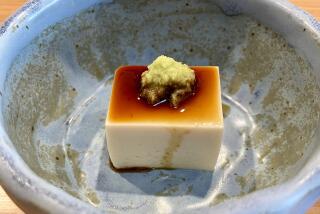The Basics of Cooking With Tofu
- Share via
Question: I’ve got some basic questions about tofu that I hope you can answer.
First, just what is tofu and what are its nutritional qualities? Is there a difference between Japanese and Chinese types of tofu? What does one do with the liquid in which it is packed? Will tofu spoil? If so, what are the signs of spoilage and how can one prevent it?
Answer: All of your questions seem to be answered in “The Von Welanetz Guide to Ethnic Ingredients” (Warner Books: 1987, $10.95). Authors Diana and Paul Von Welanetz explain that bean curd is called dou-fu or dow foo by the Chinese, tofu by the Japanese.
They go on to write, “Fresh bean curd, white and custard-like, is formed into one inch by four inch square cakes or one pound blocks packed in water, and sold in plastic containers in the refrigerator sections of many supermarkets and in health food stores.
“It may be labeled soft, medium or firm . As a general rule, the Chinese type is firmer and a bit sweeter than the Japanese. One type, yakidoufu, labeled broiled or grilled, is quite firm, and excellent for those who dislike a very soft, custardy consistency.
“Bean curd is quite inexpensive and is such a powerhouse of protein that it is often called meat without bones by the Chinese. Made from soybeans that have been soaked, pureed, cooked and solidified into curds by the addition of epsom salts, vinegar or nigari, a natural solidifier from distilled sea water, bean curd is the richest natural source of lecithin and contains all the essential amino acids. Nutritionists claim it is the only vegetable that contains a complete protein. It is very low in calories and in cholesterol and is much more easily digested than plain soybeans.”
Tofu should be used as soon as possible after purchase, but if the water is changed daily, it may be stored in the refrigerator up to a week. It develops a sour taste when spoiled. The authors do not recommend freezing bean curd, as it changes the texture.
Another response to the March 9 You Asked About . . . column on why cheesecakes crack comes from J. Lloyd of Los Angeles: “My mother’s cheesecakes always came out smooth while mine cracked. One day she told me the reason for this was that when I folded one cheese mixture into the other I was mixing in too large a volume of air, much like in a souffle, and that the cake started ‘falling’ immediately when the oven door was opened and that the cracks kept getting larger as the cake cooled.
“She told me to barely fold in one mixture to the other and that would eliminate the cracks. She was absolutely right. I never have to decorate my cheesecakes with toppings to hide the cracks.”
More to Read
Eat your way across L.A.
Get our weekly Tasting Notes newsletter for reviews, news and more.
You may occasionally receive promotional content from the Los Angeles Times.








